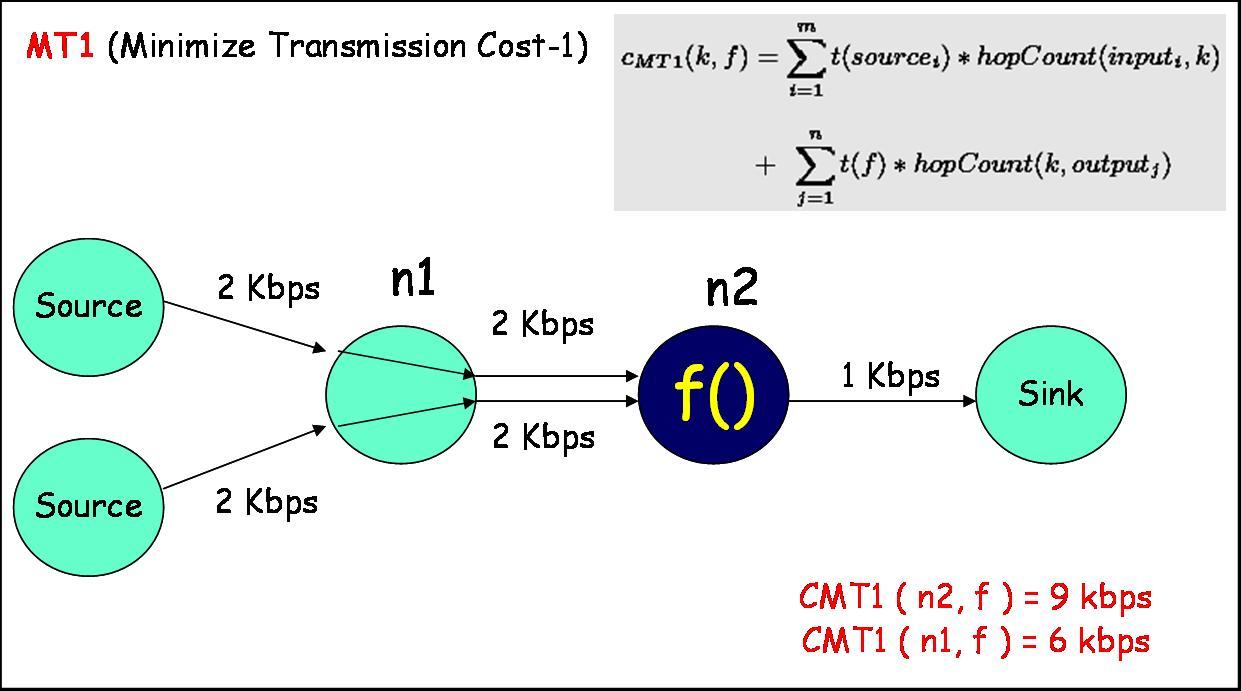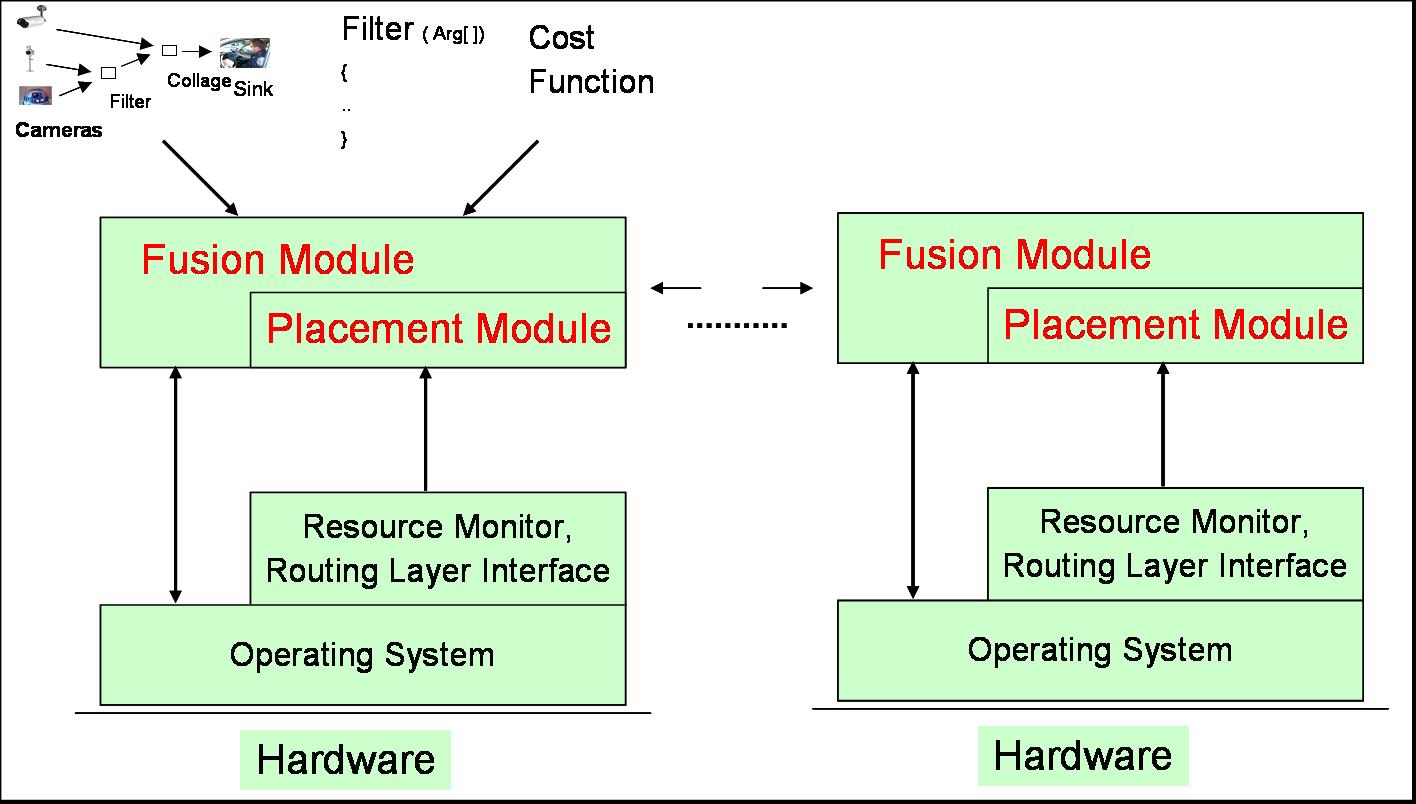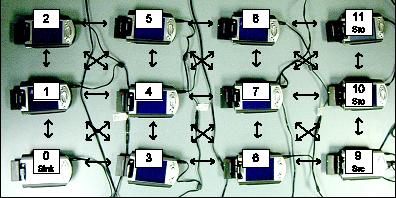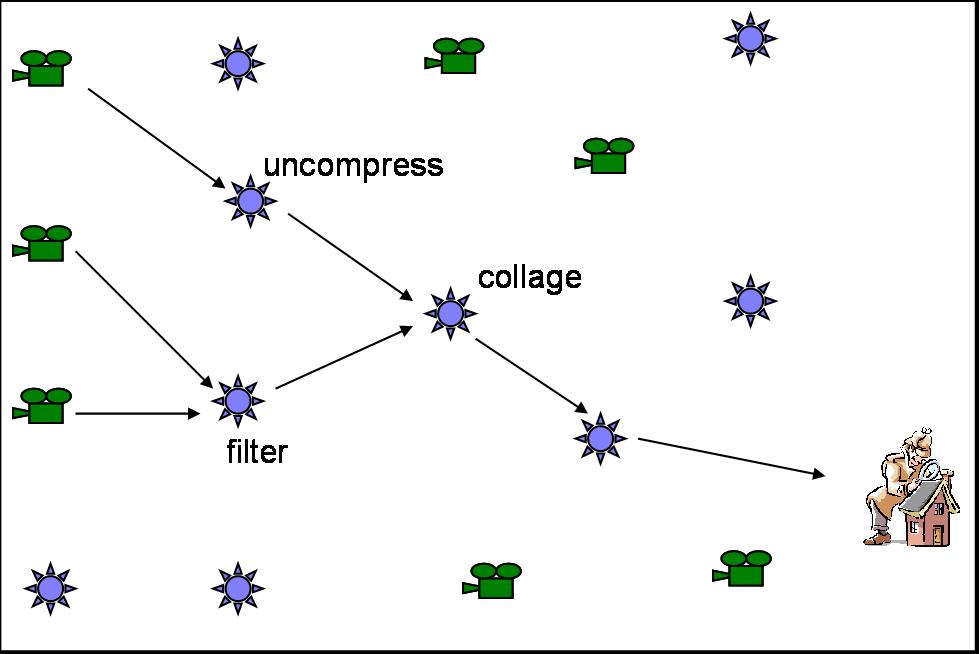A framework for distributed data fusion
Vision
Simple in-network data aggregation (or fusion) techniques for sensor networks have been the focus of several recent research efforts, but they are insufficient to support advanced fusion applications. We extend these techniques to future sensor networks and ask two related questions:
- What is the appropriate set of data fusion techniques?
- How do we dynamically assign aggregation roles to the nodes of a sensor network?
Architecture Overview
Sample application
Consider a
simplified sensor network based surveillance application that provides
filtered and collaged images efficiently to a security guard. Let
the directed graph in the image below be an
example deployment of this
application across nodes that can perform computation and relay
services in addition to connecting a physical sensor to the
network. Three cameras feed video into the network, which
performs in-network computation to provide the security guard with the
required information.
The security guard's PDA might be able to perform all of the computations, but performing them in a distributed fashion in the sensor network enables power saving, critical for application longevity. Furthermore, migrating computation (and associated communication loads) within the sensor network dynamically while the application is running can further increase application longevity.
Fusion Channels

DFuse provides
a Fusion Channel abstraction
which encapsulates a general "fusion function" (filter, collage, ...),
providing data buffering and synchronization facilities.
Instances of these fusion channels can be migrated across nodes in a
sensor network at runtime.
Cost Functions

DFuse's Placement Module employs
application-specified
cost functions to drive the dynamic migration of fusion channels in the
network. MT1 is one such function meant to minimize communication
(and hence radio power drain). With fusion channel f mapped to n2, aggregate source-sink bandwidth
is 9kbps. As f appears
to currently be performing data contraction, migrating it to n1 (closer to the sources) should
lower this communication cost to 6 kbps. Anticipated migration
overhead is ignored here, but is used in DFuse deployments.
Determination of when to migrate a particular fusion channel is a local decision, evaluated periodically by nodes hosting fusion channels. Currently, only immediate neighbor nodes are queried to see if their cost for hosting the fusion channel would be lower, but we are exploring local-minima escape mechanisms such as including 2- or 3-hop neighbors in a more expensive, but less frequent decision.
Determination of when to migrate a particular fusion channel is a local decision, evaluated periodically by nodes hosting fusion channels. Currently, only immediate neighbor nodes are queried to see if their cost for hosting the fusion channel would be lower, but we are exploring local-minima escape mechanisms such as including 2- or 3-hop neighbors in a more expensive, but less frequent decision.
Putting it all together

Given an application task-graph,
application-specific fusion functions and cost functions, the DFuse
middleware deploys the application on a target sensor network.
Each node in the network provides monitoring information to DFuse's
placement module (remaining battery; and network, CPU, memory
usage). Following an initial "naive" deployment, the mapping of
the task graph to the nodes in the network is dynamically adjusted by
the placement module's cost-function evaluation in response to
application and resource behavior.
Current Work

We have published experiments on an iPAQ farm show that the fusion API has low-overhead, and the role assignment algorithm with role migration significantly increases the network lifetime compared to any static assignment. We are continuing research by:
- exploring additional mapping heuristics
- exploring placement and device synergies (CPU clock, voltage scaling)
- performing simulation-based performance and scalability studies
- collecting CPU and memory usage in addition to communication for cost function inputs
- integrating support for application developers: tools for describing DFuse inputs and for runtime debugging
- using analytical models for discovering performance bounds
- developing mechanisms to efficiently support multiple concurrent applications
- developing more efficient sensor network stacks suitable for DFuse
- exploring stack and heuristic support for mobility efficiency
- and using driving applications on real deployments.
References
- Umakishore Ramachandran, Rajnish Kumar, Matthew Wolenetz, Brian Cooper, Bikash Agarwalla, JunSuk Shin, Phillip Hutto, and Arnab Paul. Dynamic Data Fusion for Future Sensor Networks . ACM Transactions on Sensor Networks, August 2006.
- Rajnish Kumar, Santashil PalChaudhuri, and Umakishore Ramachandran. System Support for Cross-layering in Sensor Network Stack . The 2nd International Conference on Mobile Ad-hoc and Sensor Networks (MSN 2006)
- Rajnish Kumar, Matthew Wolenetz, Bikash Agarwalla, JunSuk Shin, Phillip Hutto, Arnab Paul, and Umakishore Ramachandran. DFuse: A Framework for Distributed Data Fusion. ACM SenSys 2003.
Collaborators
- Rajnish Kumar
(rajnish at cc dot gatech dot edu)
- Matthew Wolenetz
(wolenetz at cc dot gatech dot edu)
- Bikash Agarwalla (bikash at cc dot gatech dot edu)
- JunSuk Shin (espress at cc dot gatech dot edu)
- Phillip Hutto (pwh at cc dot gatech dot edu)
- Arnab Paul (arnab at cc dot gatech dot edu)
- Umakishore
Ramachandran (rama at cc dot gatech dot edu)
- Jinpeng Wei (weijp at cc dot gatech dot edu)
